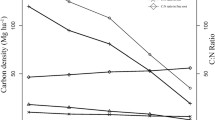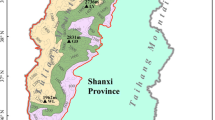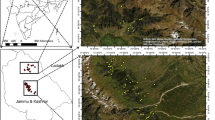Abstract
Quantifying forest carbon (C) storage and distribution is important for forest C cycling studies and terrestrial ecosystem modeling. Forest inventory and allometric approaches were used to measure C density and allocation in six representative temperate forests of similar stand age (42–59 years old) and growing under the same climate in northeastern China. The forests were an aspen-birch forest, a hardwood forest, a Korean pine plantation, a Dahurian larch plantation, a mixed deciduous forest, and a Mongolian oak forest. There were no significant differences in the C densities of ecosystem components (except for detritus) although the six forests had varying vegetation compositions and site conditions. However, the differences were significant when the C pools were normalized against stand basal area. The total ecosystem C density varied from 186.9 tC hm−2 to 349.2 tC hm−2 across the forests. The C densities of vegetation, detritus, and soil ranged from 86.3–122.7 tC hm−2, 6.5–10.5 tC hm−2, and 93.7–220.1 tC hm−2, respectively, which accounted for 39.7% ± 7.1% (mean ± SD), 3.3% ± 1.1%, and 57.0% ± 7.9% of the total C densities, respectively. The overstory C pool accounted for > 99% of the total vegetation C pool. The foliage biomass, small root (diameter < 5mm) biomass, root-shoot ratio, and small root to foliage biomass ratio varied from 2.08–4.72 tC hm−2, 0.95–3.24 tC hm−2, 22.0%–28.3%, and 34.5%–122.2%, respectively. The Korean pine plantation had the lowest foliage production efficiency (total biomass/foliage biomass: 22.6 g g−1) among the six forests, while the Dahurian larch plantation had the highest small root production efficiency (total biomass/small root biomass: 124.7 g g−1). The small root C density decreased with soil depth for all forests except for the Mongolian oak forest, in which the small roots tended to be vertically distributed downwards. The C density of coarse woody debris was significantly less in the two plantations than in the four naturally regenerated forests. The variability of C allocation patterns in a specific forest is jointly influenced by vegetation type, management history, and local water and nutrient availability. The study provides important data for developing and validating C cycling models for temperate forests.
Similar content being viewed by others
References
FAO. Global forest resource assessment: Progress towards sustainable forest management. In: FAO (ed). FAO Forestry Paper. Rome, 2005: 147
Fang J, Piao S, Zhao S. The carbon sink: The role of the middle and high latitudes terrestrial ecosystems in the northern Hemisphere. Acta Phytoecol Sinica, 2001, 25: 594–602
Goodale C L, Apps M J, Birdsey R A, et al. Forest carbon sinks in the northern hemisphere. Ecol Appl, 2002, 12: 891–899, 10.1890/1051-0761(2002)012[0891:FCSITN]2.0.CO;2
Myneni R B, Dong J, Tucker C J, et al. A large carbon sink in the woody biomass of northern forests. Proc Natl Acad Sci USA, 2001, 98: 14784–14789, 10.1073/pnas.261555198, 11742094, 1:CAS:528:DC%2BD38XptlGl
White A, Cannell M G R, Friend A D. The high-latitude terrestrial carbon sink: A model analysis. Global Change Biol, 2000, 6: 227–245, 10.1046/j.1365-2486.2000.00302.x
Melillo J M, McGuire A D, Kicklighter D W, et al. Global climate change and terrestrial net primary production. Nature, 1993, 363: 234–240, 10.1038/363234a0, 1:CAS:528:DyaK3sXksFeiu78%3D
Cao M, Woodward F I. Dynamic responses of terrestrial ecosystem carbon cycling to global climate change. Nature, 1998, 393: 249–252, 10.1038/30460, 1:CAS:528:DyaK1cXjtlylsb4%3D
Jastrow J D, R. Michael Miller, Matamala R, et al. Elevated atmospheric carbon dioxide increases soil carbon. Global Change Biol, 2005, 11: 2057–2064, 10.1111/j.1365-2486.2005.01077.x
Phillips O L, Malhi Y, Higuchi N, et al. Changes in the carbon balance of tropical forests: Evidence from long-term plots. Science, 1998, 282: 439–442, 10.1126/science.282.5388.439, 9774263, 1:CAS:528:DyaK1cXmslaqu74%3D
Schimel D S, House J I, Hibbard K A. Recent patterns and mechanisms of carbon exchange by terrestrial ecosystems. Nature, 2001, 414: 169–172, 10.1038/35102500, 11700548, 1:CAS:528:DC%2BD3MXosFaisLo%3D
Dixon R K, Brown S, Houghton R A, et al. Carbon pools and flux of global forest ecosystems. Science, 1994, 263: 185–190, 10.1126/science.263.5144.185, 17839174, 1:CAS:528:DyaK2cXhs12gsbc%3D
Malhi Y, Baldocchi D D, Jarvis P G. The carbon balance of tropical, temperate and boreal forests. Plant Cell Environ, 1999, 22: 715–740, 10.1046/j.1365-3040.1999.00453.x, 1:CAS:528:DyaK1MXksVartb8%3D
Litton C M, Raich J W, Ryan M G. Carbon allocation in forest ecosystems. Global Change Biol, 2007, 13: 2089–2109, 10.1111/j.1365-2486.2007.01420.x
Wang C, Gower S T, W Y H, et al. The influence of fire on carbon distribution and net primary production of boreal Larix gmelinii forests in north-eastern China. Global Change Biol, 2001, 7: 719–730, 10.1046/j.1354-1013.2001.00441.x
Law B E, Thornton P E, Irvine J, et al. Carbon storage and fluxes in ponderosa pine forests at different developmental stages. Global Change Biol, 2001, 7: 755–777, 10.1046/j.1354-1013.2001.00439.x
Litton C M, Ryan M G, Knight D H. Effects of tree density and stand age on carbon allocation patterns in postfire lodgepole pine. Ecol Appl, 2004, 14: 460–475, 10.1890/02-5291
Peichl M, Arain A A. Above- and belowground ecosystem biomass and carbon pools in an age-sequence of temperate pine plantation forests. Agr Forest Meteorol, 2006, 140: 51–63, 10.1016/j.agrformet.2006.08.004
Pregitzer K S, Euskirchen E S. Carbon cycling and storage in world forests: Biome patterns related to forest age. Global Change Biol, 2004, 10: 2052–2077, 10.1111/j.1365-2486.2004.00866.x
Wang C, Bond-Lamberty B, Gower S T. Carbon distribution of a well- and poorly-drained black spruce fire chronosequence. Global Change Biol, 2003, 9: 1066–1079, 10.1046/j.1365-2486.2003.00645.x
Zhu B, Wang X, Fang J, et al. Altitudinal changes in carbon storage of temperate forests on Mt Changbai, northeast China. J Plant Res, 2010, 123: 439–452, 10.1007/s10265-009-0301-1, 20127501
Litton C M, Ryan M G, Tinker D B, et al. Belowground and aboveground biomass in young postfire lodgepole pine forests of contrasting tree density. Can J Forest Res, 2003, 33: 351–363, 10.1139/x02-181
Fang J, Guo Z, Piao S, et al. Terrestrial vegetation carbon sinks in China, 1981–2000. Sci China Ser-D: Earth Sci, 2007, 50: 1341–1350, 10.1007/s11430-007-0049-1, 1:CAS:528:DC%2BD2sXht1yiurrO
Luyssaert S, Inglima I, Jung M, et al. CO2 balance of boreal, temperate, and tropical forests derived from a global database. Global Change Biol, 2007, 13: 2509–2537, 10.1111/j.1365-2486.2007.01439.x
Yang J, Wang C. Soil carbon storage and flux of temperate forest ecosystems in northeastern China. Acta Ecol Sinica, 2005, 25: 2875–2882, 1:CAS:528:DC%2BD28Xmt1ClsQ%3D%3D
Peng C, Zhou X, Zhao S, et al. Quantifying the response of forest carbon balance to future climate change in northeastern China: Model validation and prediction. Global Planetary Change, 2009, 66: 179–194, 10.1016/j.gloplacha.2008.12.001
Wang C. Biomass allometric equations for 10 co-occurring tree species in Chinese temperate forests. Forest Ecol Manage, 2006, 222: 9–16, 10.1016/j.foreco.2005.10.074
Piao S, Fang J, Ciais P, et al. The carbon balance of terrestrial ecosystems in China. Nature, 2009, 458: 1009–1013, 10.1038/nature07944, 19396142, 1:CAS:528:DC%2BD1MXkvFKhtLc%3D
Wang C K, Yang J Y, Zhang Q Z. Soil respiration in six temperate forests in China. Global Change Biol, 2006, 12: 2103–2114, 10.1111/j.1365-2486.2006.01234.x
Quan X, Wang C, Zhang Q, et al. Dynamics of fine roots in five Chinese temperate forests. J Plant Res, 2010, 123: 497–507, 10.1007/s10265-010-0322-9, 20217175
Zhang Q, Wang C, Wang X, et al. Carbon concentration variability of 10 Chinese temperate tree species. Forest Ecol Manage, 2009, 258: 722–727, 10.1016/j.foreco.2009.05.009
Vogt K A, Vogt D J, Bloomfield J. Analysis of some direct and indirect methods for estimating root biomass and production of forests at an ecosystem level. Plant Soil, 1998, 200: 71–89, 10.1023/A:1004313515294, 1:CAS:528:DyaK1cXktVKktb4%3D
Gower S T, Vogel J G, Norman J M, et al. Carbon distribution and aboveground net primary production in aspen, jack pine, and black spruce stands in Saskatchewan and Manitoba, Canada. J Geophys Res, 1997, 102: 29029–29042, 10.1029/97JD02317, 1:CAS:528:DyaK1cXnslygtw%3D%3D
Wang X P, Fang J Y, Zhu B. Forest biomass and root-shoot allocation in northeast China. Forest Ecol Manage, 2008, 255: 4007–4020, 10.1016/j.foreco.2008.03.055
Martin J L, Gower S T, Plaut J, et al. Carbon pools in a boreal mixedwood logging chronosequence. Global Change Biol, 2005, 11: 1883–1894
Vargas R, Allen M F, Allen E B. Biomass and carbon accumulation in a fire chronosequence of a seasonally dry tropical forest. Global Change Biol, 2008, 14: 109–124
Jackson R, Mooney H, Schulze E. A global budget for fine root biomass, surface area, and nutrient contents. Proc Natl Acad Sci USA. 1997, 94: 7362, 10.1073/pnas.94.14.7362, 11038557, 1:CAS:528:DyaK2sXksFOmtL4%3D
Chiba Y. Architectural analysis of relationship between biomass and basal area based on pipe model theory. Ecol Model, 1998, 108: 219–225, 10.1016/S0304-3800(98)00030-1
Baker T, Phillips O, Malhi Y, et al. Variation in wood density determines spatial patterns in Amazonian forest biomass. Global Change Biol, 2004, 10: 545–562, 10.1111/j.1365-2486.2004.00751.x
Helmisaari H, Derome J, Nojd P, et al. Fine root biomass in relation to site and stand characteristics in Norway spruce and Scots pine stands. Tree Physiol, 2007, 27: 1493, 17669739, 1:CAS:528:DC%2BD2sXhtlWjsrvO
Makela A, Valentine H T, Helmisaari H S. Optimal co-allocation of carbon and nitrogen in a forest stand at steady state. New Phytol, 2008, 180: 114–123, 10.1111/j.1469-8137.2008.02558.x, 18637066, 1:CAS:528:DC%2BD1cXht1ait7bM
Litton C M, Giardina C P. Below-ground carbon flux and partitioning: Global patterns and response to temperature. Funct Ecol, 2008, 22: 941–954, 10.1111/j.1365-2435.2008.01479.x
Aber J, Melillo J, Nadelhoffer K, et al. Fine root turnover in forest ecosystems in relation to quantity and form of nitrogen availability: A comparison of two methods. Oecologia, 1985, 66: 317–321, 10.1007/BF00378292
Pastor J, Post W. Influence of climate, soil moisture, and succession on forest carbon and nitrogen cycles. Biogeochem, 1986, 2: 3–27, 10.1007/BF02186962
Vande Walle I, Mussche S, Samson R, et al. The above- and belowground carbon pools of two mixed deciduous forest stands located in east-Flanders (Belgium). Ann Forest Sci, 2001, 58: 507–517, 10.1051/forest:2001141
Canadell J, Jackson R, Ehleringer J, et al. Maximum rooting depth of vegetation types at the global scale. Oecologia, 1996, 108: 583–595, 10.1007/BF00329030
Brassard B W, Chen H Y H, Bergeron Y. Influence of environmental variability on root dynamics in northern forests. Crit Rev Plant Sci, 2009, 28: 179–197, 10.1080/07352680902776572
Jobbágy E, Jackson R. The distribution of soil nutrients with depth: Global patterns and the imprint of plants. Biogeochem, 2001, 53: 51–77, 10.1023/A:1010760720215
Kozlowski T T, Pallardy S G. Physiology of Woody Plants. San Diego: San Diego Academic Press, 1996
Jackson R B, Canadell J, Ehleringer J R, et al. A global analysis of root distributions for terrestrial biomes. Oecologia, 1996, 108: 389–411, 10.1007/BF00333714
Gower S T, Richards J H. Larches: Deciduous conifers in an evergreen world. Bioscience, 1990, 40: 818–826, 10.2307/1311484
Fang J Y, Liu G H, Zhu B, et al. Carbon budgets of three temperate forest ecosystems in Dongling Mt., Beijing, China. Sci China Ser-D Earth Sci, 2007, 50: 92–101, 10.1007/s11430-007-2031-3
Gough C, Vogel C, Kazanski C, et al. Coarse woody debris and the carbon balance of a north temperate forest. Forest Ecol Manage, 2007, 244: 60–67, 10.1016/j.foreco.2007.03.039
Sturtevant B, Bissonette J, Long J, et al. Coarse woody debris as a function of age, stand structure, and disturbance in boreal Newfoundland. Ecol Appl, 1997, 7: 702–712, 10.1890/1051-0761(1997)007[0702:CWDAAF]2.0.CO;2
Yanai R, Arthur M, Siccama T, et al. Challenges of measuring forest floor organic matter dynamics: Repeated measures from a chronosequence. Forest Ecol Manage, 2000, 138: 273–283, 10.1016/S0378-1127(00)00402-3
Cornelissen J, Grime J, Marzano B, et al. Leaf structure and defence control litter decomposition rate across species and life forms in regional floras on two continents. New Phytol, 1999, 143: 191–200, 10.1046/j.1469-8137.1999.00430.x
Liu S, Li X, Niu L. The degradation of soil fertility in pure larch plantations in the northeastern part of China. Ecol Eng, 1998, 10: 75–86, 10.1016/S0925-8574(97)10024-6
Chapin III F S, Matson P A, Mooney H A. Principles of Terrestrial Ecosystem Ecology. New York: Springer-Verlag, New York, Inc., 2002
Jobbágy E, Jackson R. The vertical distribution of soil organic carbon and its relation to climate and vegetation. Ecol Appl, 2000, 10: 423–436, 10.1890/1051-0761(2000)010[0423:TVDOSO]2.0.CO;2
Binkley D. The influence of tree species on forest soils: Processes and patterns. Agronomy Society Of New Zealand Special Publication, 1995: 1–34
Author information
Authors and Affiliations
Corresponding author
Rights and permissions
About this article
Cite this article
Zhang, Q., Wang, C. Carbon density and distribution of six Chinese temperate forests. Sci. China Life Sci. 53, 831–840 (2010). https://doi.org/10.1007/s11427-010-4026-0
Received:
Accepted:
Published:
Issue Date:
DOI: https://doi.org/10.1007/s11427-010-4026-0




